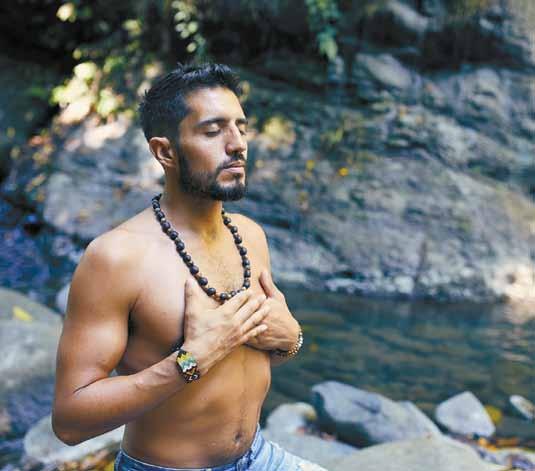For healing arts practitioner Evelyn Hall, in Santa Cruz, California, mindfulness is a lifestyle choice. “When my mind runs off into the future, it can create not only anxiety because I fear the unknown, but also worry about all the ‘what ifs’. When I find myself lost in the past, it can bring me sadness and regret. I have learned from mindfulness that these are just mental habits.” Cara Bradley, a mental fitness coach in Philadelphia and author of On the Verge: Wake Up, Show Up and Shine, says, “To be mindful is to show up to experience the moment as it is, with all your senses— when we eat, when we walk, whatever we are doing.”
healing ways
darius bashar/Unsplash.com
Diving Deeper
Tools for Inner Peace
Exploring Mindfulness and Meditation by Marlaina Donato
T
he practices of mindfulness and meditation, although closely related, offer individual, science-backed benefits for both body and psyche. Mindfulness has been shown to amp up immunity and increase gray matter in the brain, and 2018 research published in Experimental Biology shows that just an introductory hour of meditation using breathwork and awareness of thoughts significantly reduced anxiety. The study indicates that when applied regularly, mindfulness minimizes arterial pressure and cardiovascular health risks associated with long-term nervous system stress.
Immersion in the Moment Mindfulness—cultivating present-moment awareness by noticing body sensations, thoughts and details in our environment—not only makes life more enjoyable, but enables us to acknowledge life experiences and emotions without aversion and judgement. Mindfulness techniques are now being used in psychotherapy for insomnia, eating disorders and addictions. Physiological benefits are also significant. Harvard Health Publishing, referencing the work of Jon Kabat-Zinn at the University of Massachusetts Medical Center, highlights mindfulness for cardiovascular and gastrointestinal conditions, as well as clinical depression. 38
Tampa Bay Edition
NATampa.com
While mindfulness can be the simple act of noticing the geometric design of a flower or the variety of tastes on a dinner plate, meditation brings awareness to the deepest levels of consciousness through a variety of focused techniques, including breathwork, chanting, visualization or gazing at a candle flame. Contrary to common assumption, meditation need not be associated with religious structure. Neuroscientist Tony Nader, who heads the global Transcendental Meditation (TM) organization in 100 countries, underscores, “When you say meditation, there are numerous kinds of meditation with different origins. It can’t be assumed that just because meditation involves the mind that it involves dogma, or that meditation is religious because it has its roots from the Eastern traditions. Over time, some traditions integrated aspects of these ancient techniques into their own religions, yet not all meditations are religious.” Meditation can bring us into the eye of the storm. “The ocean is a great analogy for understanding different approaches to meditation. Just as the ocean can be turbulent on the surface with innumerable waves and quiet at its depth, so, too, the mind is active on the surface with innumerable thoughts, but it is also naturally, profoundly quiet, deep within.” TM, taught in personal, one-to-one instruction by a certified instructor, is one










